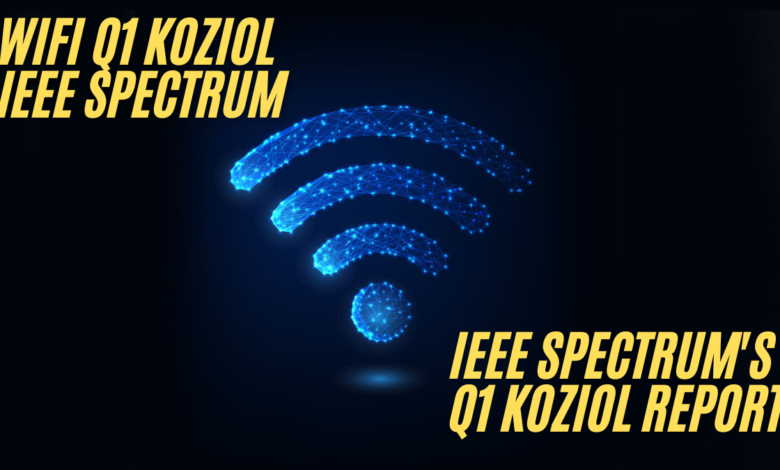WiFi Q1 Koziol IEEE Spectrum: Revolutionizing Wireless Communication and Connectivity

In today’s hyperconnected world, the demand for fast, reliable, and innovative wireless communication is more critical than ever. With the emergence of next-generation WiFi Q1 Koziol IEEE Spectrum technologies, one particular keyword is capturing attention across tech communities and engineering publications alike: WiFi Q1 Koziol IEEE Spectrum . This term encapsulates a growing trend in wireless research and development, hinting at groundbreaking advancements that are reshaping the future of networking.
What is WiFi Q1Koziol IEEE Spectrum?
To understand the full scope of WiFi Q1 Koziol IEEE Spectrum , it’s important to break down the components:

- WiFi: The familiar wireless communication standard used globally for internet access.
- Q1Koziol: Refers to a specialized wireless protocol or chipset variant under development, possibly named after a lead researcher or technology contributor.
- IEEE Spectrum: The flagship magazine of the IEEE (Institute of Electrical and Electronics Engineers), a source of cutting-edge scientific and technical information.
Together, WiFi Q1Koziol IEEE Spectrum points toward a significant innovation in WiFi systems, particularly one gaining traction in scholarly discussions and R&D communities.
The Technology Behind WiFi Q1Koziol IEEE Spectrum
The WiFi Q1 Koziol IEEE Spectrum standard builds on traditional WiFi Q1 Koziol IEEE Spectrum protocols (like 802.11ax and 802.11be) by incorporating more efficient spectrum utilization, beamforming, and enhanced MIMO (multiple input, multiple output) technologies. These upgrades significantly improve speed, reduce latency, and extend range—core elements for high-performance environments like smart homes, autonomous vehicles, and industrial IoT systems.
One standout feature of WiFi Q1 Koziol IEEE Spectrum its potential to optimize bandwidth allocation in congested urban environments. Traditional WiFi often struggles in densely populated areas. However, the Q1Koziol model integrates intelligent frequency hopping and AI-driven signal management to minimize interference and maintain stable connections.
Practical Applications and Benefits
The implications of WiFi Q1Koziol IEEE Spectrum span across multiple industries:
1. Smart Cities
Cities that rely on real-time data (from traffic monitoring to energy usage) benefit from the ultra-reliable, low-latency connections offered by WiFi Q1 Koziol IEEE Spectrum . It enhances communication between IoT devices and central control systems.
2. Healthcare
In hospitals and remote health monitoring systems, stability and speed are crucial. WiFi WiFi Q1 Koziol IEEE Spectrum ensures that sensitive patient data is transmitted without interruption, supporting telemedicine and digital diagnostics.
3. Education
With the increase in e-learning and virtual classrooms, high-quality WiFi Q1 Koziol IEEE Spectrum is a necessity. WiFi Q1Koziol IEEE Spectrum makes it easier for institutions to provide seamless access to cloud platforms and learning management systems.
4. Gaming and Entertainment
Gamers demand low latency and high-speed internet. WiFi Q1Koziol IEEE Spectrum enhances multiplayer performance and cloud gaming experiences by reducing lag and boosting bandwidth.
5. Industrial Automation
Factories and warehouses implementing Industry 4.0 technologies need WiFi that can handle vast numbers of connected devices. WiFi Q1Koziol IEEE Spectrum provides the backbone for such environments with exceptional device density handling.
How Does It Compare to Previous Standards?
Compared to legacy systems, WiFi Q1Koziol IEEE Spectrum offers:
- Up to 40% more spectral efficiency
- Lower energy consumption, especially for battery-powered devices
- More stable performance in high-mobility environments (e.g., moving trains, drones)
- Expanded coverage, thanks to adaptive beamforming and channel aggregation
These improvements make WiFi Q1 Koziol IEEE Spectrum a competitive option even against emerging alternatives like Li-Fi or 5G.
Insights from IEEE Spectrum
IEEE Spectrum, known for its rigorous peer-reviewed content, has spotlighted WiFi Q1Koziol IEEE Spectrum as one of the most promising WiFi Q1 Koziol IEEE Spectrum evolutions to date. According to recent articles, engineers working on this project have successfully demonstrated early-stage testing in complex environments, such as underground parking structures and large sports arenas.
One article, titled “Redefining Wireless Efficiency with WiFi Q1Koziol”, praises its ability to maintain a connection even under high interference and device congestion—an area where most conventional WiFi falters.
Challenges and Ongoing Research
Like any developing technology, WiFi Q1Koziol IEEE Spectrum faces challenges:
- Hardware Compatibility: Many current devices need firmware or chipset upgrades to fully utilize the new protocol.
- Cost of Deployment: As with any new infrastructure, initial costs for routers and access points supporting WiFi Q1 Koziol IEEE Spectrum may be higher.
- Standardization: Before it becomes mainstream, the IEEE must finalize and approve its technical specifications.
Nonetheless, these hurdles are being addressed by research teams and tech giants eager to capitalize on the performance benefits that WiFi Q1Koziol IEEE Spectrum offers.
Market Outlook
The global market for WiFi technology is expected to exceed $25 billion by 2030. With the advent of WiFi Q1Koziol IEEE Spectrum, analysts predict a shift in consumer demand toward routers and devices that support this advanced technology. Companies like Intel, Qualcomm, and Broadcom are reportedly investing in next-gen chipsets designed to be compatible with the Q1Koziol framework.
Moreover, as digital transformation accelerates worldwide, the need for robust wireless solutions will only grow. This puts WiFi Q1Koziol IEEE Spectrum in a prime position to lead the next wave of WiFi innovation.
Final Thoughts
The world of wireless connectivity is rapidly evolving, and WiFi Q1Koziol IEEE Spectrum is emerging as a game-changer in this space. From improving everyday home internet use to empowering mission-critical applications in smart industries, this technology represents a leap forward in how we experience the digital world.
As more attention is drawn to the advancements featured in WiFi Q1Koziol IEEE Spectrum, it’s clear that this isn’t just a fleeting tech trend—it’s a foundational shift in wireless communications.
For tech enthusiasts, developers, and organizations aiming to stay ahead, keeping an eye on WiFi Q1Koziol IEEE Spectrum is not just advisable—it’s essential.



